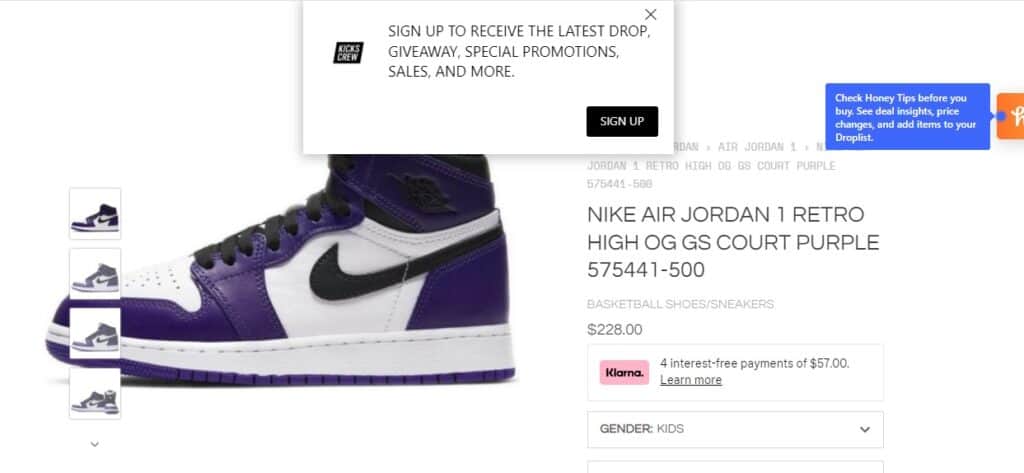Nike revolutionized athletic footwear in 1984 with a new high-end basketball shoe called the Air Jordan. Now known as the Jordan 1, this model was designed specifically for the then aspiring basketball player Michael Jordan. Soon Michael Jordan became a legend, and his sneakers would propel Nike and later Jordan Brand into the forefront of sports-wear manufacturing.
How much do real Jordans cost? If you can get them at retail price, real Jordans cost approximately $150. Although, you might find them at higher prices depending on the style and release concept. Unfortunately due to the rise in online resale markets, it is often hard to get the Jordan’s you want for the price you should pay. In addition a lot of people frequently fall for fake Jordans, which often cost the same price.

Nike Air Jordan sports shoes have long been the benchmark for quality and design for many buyers. The popularity of the brand causes a broad exposure in the market and many people purchase them.
How to Distinguish Real Jordans from Fake?
If you decide to buy Jordan shoes in the store there are chances that you might encounter a fake one. Even though you will often find Jordans that cost $200 and more the chances of coming across a fake pair of shoes is high. Here are some of the important tips that will guide you through the selection process.
Appearance
The original Jordan sneakers are very well made. There can be no glue streaks and protruding threads on them. The line is always even, which cannot be achieved in artisanal production.
Code
Original sneakers are always packed in a branded box. The code on the package and on the tag, which is sewn, must match. According to these figures, you can check the authenticity of the model on the official website.
Label
Fake manufacturers often save on this small but important detail. On branded shoes, the logo is embroidered with satin stitch and neatly sewn on. On a copy, it can be glued or inked.
Holes for Laces
The distance between the eyelets should be the same. On the originals, the holes are the same size and shape.
Straight Stitch
The distance between the seams is 2-3 mm. The line should be made with thin threads evenly and without repetitions. On fake shoes, coarse threads of different shades are often used.
Sole
On branded sneakers, it is matte, for the production of which expensive material is used. The soles on fake shoes are most often made of inexpensive rubber and are soft and shiny.
Insoles
This is the difference that characterizes the branded pair of sneakers. On the inside of the insole, the brand logo is clearly visible, which is absent on fakes.
Size
Branded Air Jordan sneakers are made to size. They can be bought without trying on, which cannot be said about fake shoes.
History of Jordans
In 1988, thanks to Tinker Hatfield, designer of the Nike offices, the new Jordan III Retro was created. Tinker was not afraid to make his own amendments to the old design, and also attracted Michael Jackson himself to work on the model. The model itself was undoubtedly the best, produced in different colors and using a variety of materials.
The long-awaited return of Michael Jordan in 1995 made a splash in the world of basketball fans! Sneakers began to be swept off the shelves at an incredible speed, and the fact that they were produced in limited quantities only ignited the interest of buyers more.
It is not surprising that even after so many years, the Jordan sneaker model is still the most popular and famous because it is for true connoisseurs of comfort and style.
Main Direction
The main focus of the company is high-quality expensive basketball shoes and clothing. The brand originates from 1984, when Phil Knight, Chairman of the Board of Directors of Nike, signed a contract with the newcomer of the National Basketball Association Michael Jordan. Nike signed a deal with him for $5 million for a period of 5 years, plus interest and additional privileges. The introduction of the first Air Jordan revolutionized the athletic shoe industry. Up to this point, virtually all Air Jordan basketball shoes were white.
The Air Jordan 3 Retro was designed by Tinker Hatfield, who originally worked for Nike as a store and office designer. During this period, Michael Jordan wanted to end his partnership with the company, but the Air Jordan 3 Retro completely changed his mind. It was the revolutionary design of the sneaker, the visible Air-unit, the new Jumpman logo, the famous elephant print, all of which created a unique image. In the future, this model became a cult and was reissued in different colours, using different materials.
The appearance of the model was so bold that the NBA even forbade Michael Jordan to wear them, but he, in spite of everything, continued to play only in them, for which he often paid very large fines.
The Air Jordan 11 Retro was also designed and developed by Tinker Hatfield. In 1995, Michael Jordan retired from basketball and switched to professional baseball. Tinker Hatfield hoped that Michael would return to the world of basketball and play in them while designing the Air Jordan 11 Retro.
Almost every model in the Air Jordan series is reissued, some of them more than once. Everyone knows that they are the most ardent object of adoration and collecting among fans of sports shoes. It’s no secret that the models of this particular series are recognized as the most anticipated among buyers of basketball shoes.
From time to time new models are created and the popularity of the brand does not die down. Because of that there are more volunteers that want to purchase the sneakers.
